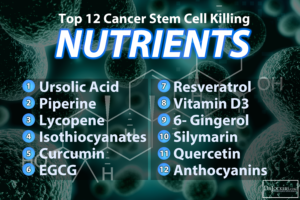
In the early 1960s, Turkish doctor Huseyin Ziya Ozel discovered an age-old Turkish folk remedy for cancer and other illness based on the common oleander plant.
https://thetruthaboutcancer.com/oleander-extract/?utm_campaign=oleander-extract&utm_medium=email&&utm_content=2017-09-01
Healthiest Cooking Oil Comparison Chart with Smoke Points and Omega 3 Fatty Acid Ratios

This is a very useful chart of oil smoke points that shows you what to use when.
https://jonbarron.org/diet-and-nutrition/healthiest-cooking-oil-chart-smoke-points
How Vitamin D Stops Cancer Stem Cells

Roughly 10,000 cancer cells are generated by the body every single day (7). One of the most common factors contributing to the ability for these cancer stem cells to proliferate and invade new tissue is vitamin D3 deficiency. There are a variety of influences that have resulted in vitamin D being one of the most common nutrient deficiencies in our society today, which has only fueled the growth of cancer as the nemesis of our time.
http://drjockers.com/how-vitamin-d-stops-cancer-stem-cells/
Mosqioto Bites
This weekend we saw out first fly and mosquito of the season.
If you are the “mosquitoes always seem to bite me” type, take 100 mg of B1 (thiamin) every day. Within two weeks, you should start noticing a decrease in the amount of times you’re uncomfortably smacking these pests away from your body.
If taking thiamine doesn’t work for you, try this all natural mosquito repellent recipe to help you avoid having to use chemical warfare on your body as a repellent.
All Natural Mosquito Repellent
Ingredients
Tea tree oil
Lavender oil
Witch hazel
Cooled boiled water
Instructions
Fill an 8oz. spray bottle halfway with boiled water (allow it to cool down first!)
Add ½ tsp of witch hazel
Add 15 drops of tea tree oil
Add 15 drops of lavender oil
Use as needed
From http://www.healthy-holistic-living.com/take-vitamin-repel-mosquitoes-summer-long.html
THE WEAPONIZATION OF HISTORY AND JOURNALISM
In the United States, facts, an important element of truth, are not important. They are not important in the media, politics, universities, historical explanations, or the courtroom. Non-factual explanations of the collapse of three World Trade Center buildings are served up as the official explanation. Facts have been politicized, emotionalized, weaponized and simply ignored. As David Irving has shown, Anglo-American histories of World War 2 are, for the most part, feel-good histories, as are “civil war” histories as Thomas DiLorenzo and others have demonstrated. Of course, they are feel good only for the victors. Their emotional purpose means that inconvenient facts are unpalatable and ignored.
http://www.paulcraigroberts.org/2017/08/28/weaponization-history-journalism/print/
BRUTAL ELECTROSHOCK USE ON THE RISE
Whilst most people are under the impression that electroshock therapy (ECT) is banned in Australia because the mere idea of electroshock is so abhorrent, its use has significantly increased and it is being used on the most vulnerable in society, children and the elderly.
Electroshock is the application of hundreds of volts of electricity to the brain. It can cause severe and permanent memory loss, brain damage, suicide, cardiovascular complications, intellectual impairment and even death.
The figures below indicate the Australian increases for the numbers of Medicare funded electroshock “treatments”:
2007 2016 % Increase
Australia: 18,183 33,641 85%
NSW: 4,936 8,039 63%
Vic: 4,895 8,639 76%
Qld: 4,852 9,274 91%
SA: 1,163 2,487 114%
WA: 1,457 4,242 191%
In W.A. its use is banned for under 14 year olds, in A.C.T. it is banned for those under 12 years of age – in NSW and other states there are NO restrictions on what age ECT can be given. For example: In 2013/14 there were 134 electroshocks given to Victorian children aged 10-19 and in Qld in 2014/15 there were 23 treatments given to children aged 10-15.
This barbaric practice continues on Australian children despite the World Health Organisation stating, “There are no indications for the use of ECT on minors, and hence this should be prohibited through legislation.” In March 2017, India correctly banned the use of ECT for all children under 18.
Parents need to be able to consent to their child’s medical treatment. However various state mental health acts allow for a child to be detained in a psychiatric hospital and given electroshock without their parents’ consent including at a Tribunal who give final approval, a denial of parental rights and a violation of basic human rights.
If there are no safeguards (bans) in the law regarding vulnerable children, they are denied the protection they deserve. Electroshock never addresses the cause of a child’s problem and offers no cure.
CCHR has campaigned for many years against the use of electroshock. Please help end this torturous psychiatric practice. Contact your local Member of Parliament no matter which state you live in and ask them to take action to amend your state’s mental health act to immediately ban the use of electroshock on children under 18, pregnant women and the elderly.
If you live in NSW we invite you to print off, sign and return our petition to ban this destructive practice at:
http://cchr.org.au/wp-content/uploads/2015/09/NSW-Mental-Health-Act-Petition.pdf
For further information on electroshock, read CCHR’s information sheet: “Brain Damaging Effects of Electroshock: the Facts”
http://cchr.org.au/articles/brain-damaging-effects-of-electroshock-the-facts
Use the electroconvulsive therapy Medicare Item code (14224) to obtain Medicare Statistics using this link:
http://medicarestatistics.humanservices.gov.au/statistics/mbs_item.jsp
Medicare Item Code for electroconvulsive therapy (14224) can be found here:
http://www.mbsonline.gov.au/internet/mbsonline/publishing.nsf/Content/Home
Judged By What We Destroy
It’s Not The Vaccines
You may have heard of Dr Piesse in Melbourne in relation to vaccines. He is being hounded for gaining vaccine exemptions for children.
Dr Piesse submitted a response to the Melbourne Age. Unlikely however that this will be printed by any mainstream media outlet; it’s far too much truth for them and might, God forbid, threaten parents’ unwarranted and undeserved trust in vaccination.
So, here is Dr Piesse’s statement from years and years of clinical practice and training, about the vaccination issue and why he offers parents a choice and full informed consent:
“I have been encountering cases of vaccine injury for over 40 years. In June it was a happy, healthy nearly 5-year-old whose parents were required to put her on a catch-up schedule, in order to get her into kindergarten. She won’t be going to kinder. She’s in a wheel-chair, brain-damaged. Her life ruined. Then came a friend’s father who died after a flu vaccine, and last week a 4 year old boy, made autistic by a catch-up schedule.
In 1988, the US National Vaccine Injury Compensation Program was created. It has paid out over US$3.5 billion to the vaccine-injured. The NVICP was set up to protect vaccine manufacturers from ruinous costs of litigation by vaccine-damaged people. It was deemed preferable to have ‘unavoidably unsafe’ vaccines than no vaccines. Unfortunately the protection provided to vaccine manufacturers also reduced incentives to develop safer vaccines in USA.
Politicians and doctors assure us that vaccinations are very safe although less than 5% of vaccine reactions are reported. Most are passed off as ‘just a coincidence’.
Vaccines contain health-damaging ingredients, not the least aluminium – a known neurotoxin implicated along with mercury, in brain damage as in autism, developmental delay, ADHD, and learning difficulties. Aluminium is also a powerful promoter of auto-immune diseases. Vaccines can claim to be mercury-free if their mercury content is below a still-toxic threshold. Most influenza vaccines contain mercury – also a neurotoxin. In addition, polysorbate 80 in vaccines increases the permeability of the blood brain barrier and potentiates the risks of these neurotoxins. The known presence of carcinogenic viruses in the MMR vaccine, has been covered-up. Vaccines also contain formaldehyde, a known carcinogen.
Proof of vaccine safety requires rigorously conducted clinical studies comparing vaccinated versus truly unvaccinated children for health outcomes. Are there any such studies that confirm that vaccinated children are not worse-off than those unvaccinated? No. There are none. Hence, child vaccines are unproven for safety – an inconvenient truth for a profession that prides itself on being scientific.
One analysis indicated that national infant mortality rates were proportional to the number of vaccine doses (Miller NZ 2011), contradictory to the claim that ‘vaccination saves lives’.
From mid-2015, parents who wished not to vaccinate their children, started to converge on my practice seeking assistance with gaining exemption from the penalties directed at non-vaccinators by the No Jab No Pay and No Jab No Play Legislation.
Analysis up to the end of 2016 of parent’s reasons for not vaccinating, indicated that 64% of 166 parents knew of vaccine-damaged individuals in their own family. The study of ‘Adversomics’ confirms polymorphic and genomic susceptibility factors common to vaccine–damaged individuals and their families. (Poland GA 2015). 40% of unvaccinated children had pre-existing health problems that parents considered would make them more at risk of harm from vaccines. 60% of unvaccinated children were very healthy, but only 6% of the vaccinated children. There were no cases of autism in 212 unvaccinated children, but 8 autism cases in the 50 vaccinated children (16%), and 36% with ASD, compared to 1.4% in the unvaccinated.
As yet there are no large-scale vaccinated versus truly unvaccinated studies of the sort needed prove that vaccines do or do not cause autism.
So where does the widespread belief that vaccines do not cause autism derive? In a nutshell: from an over-whelming quantity of ‘manufactured science’ of low quality, scientific fraud, and ignoring !1 evidence supporting causality. Few doctors and politicians are aware of the pivotal scientific fraud committed in the US Centers for Disease Control. A study of the MMR vaccine in black American babies showed a 2.5 fold higher level of autism in babies given the MMR vaccine at 12 months of age compared to 3 years. The CDC refused to publish these findings but manipulated the data to disguise the undeniable association found. The fraudulent data was then published (DeStefano F 2004 ) and promoted as the final statement on the question. Thereafter the official line was that vaccination did not cause autism. 5000 vaccine-damaged children had their applications in the Vaccine Court for compensation quashed after this deception. But whistle-blower William Thompson released the true unabridged data which was published briefly until pressure from the CDC forced its retraction (Hooker B 2014)
A recent study of home-school students showed a 6.6 fold increase in neurodevelopmental disorders in the vaccinated group over the unvaccinated. Autism spectrum disorders were 4.7 times more prevalent in the vaccinated children (Mawson AR 2017).
So long as doctors and governments continue to be hood-winked into believing that vaccines do not cause autism, no action will be taken to stop the alarming surge in the autism epidemic. A tragedy that need not happen if we demand good science and safe vaccines.”
– Dr Piesse, Australia
No Mandatory Vaccines

I signed this petition. You are welcome to join me!
https://www.change.org/p/malcolm-turnbull-no-mandatory-vaccinations-until-vaccines-tested-like-all-other-drugs


